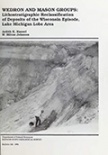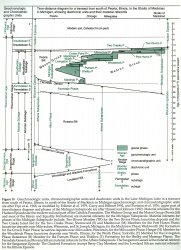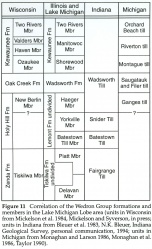Historical:Manitowoc Member
Lithostratigraphy: Wedron Group >>Kewaunee Formation >>Manitowoc Member
Chronostratigraphy: Cenozoic Erathem >>Quaternary System >>Pleistocene Series
Authors
Ardith K. Hansel and W. Hilton Johnson
Name
Original description
Manitowoc Till Member (Lineback et al. 1974).
Derivation
Manitowoc County, Wisconsin.
History/background
The Manitowoc Till Member was defined by Lineback et al. (1974) from seismic profiling and coring of the bottom sediments in Lake Michigan by the ISGS and University of Wisconsin in the early 1970s. The Manitowoc Till Member was recognized in cores as brown clayey diamicton that is typically beneath lake sediment of the Equality Formation and/or the former Lake Michigan Formation. Manitowoc diamicton contains more expandable clay minerals and less illite than the underlying Shorewood diamicton and is not as red as the overlying Two Rivers diamicton. On the seismic profiles, the distal end of the Manitowoc Till Member was interpreted to overlap the Shorewood Till Member to the south on the north side of the mid-lake bedrock high where it intertongues with lake sediment. The Manitowoc Till Member was also encountered beneath lake sediment in cores and seismic profiles taken in the central part of the lake basin by the USGS (Colman and Foster 1990).
The Manitowoc Till Member is herein classified as a member of the Kewaunee Formation and renamed the Manitowoc Member.
Type section
Core 904, taken about 45 kilometers (28 mi) southeast of Manitowoc, Wisconsin, in 95.4 meters (313 ft) of water; good for lithology.
Reference section
Core 15V; good for lithology. Kewaunee Section; good for lithology of Manitowoc-equivalent Haven Member and lower contact.
Stratigraphic relationships
The Manitowoc Member consists of the middle, brown to red brown, silty clay diamicton of the Kewaunee Formation beneath laminated sediment under Lake Michigan north of the bedrock high between the southern and northern bathymetric basins.
Manitowoc diamicton contains more expandable clay minerals, less illite, and more vermiculite than Shorewood diamicton. It is redder than Shorewood diamicton, but not as red as Two Rivers diamicton. Compared to the diamicton of adjacent members, diamicton of the Manitowoc Member contains more total carbonates in the clay fraction, with dolomite greatly predominating (Wickham et. al. 1978). Lineback et al. (1974) and Foster and Colman (1991) identified the Equality Formation that intertongues with the diamicton members of the Kewaunee Formation along their outermost margins. These tongues of sorted sediment help to differentiate the boundaries between members.
Extent and thickness
The Manitowoc Member was mapped by Lineback et al. (1974) beneath Lake Michigan over most of the area north of the mid-lake bedrock high in the Lake Michigan basin. Because of considerable relief on the bedrock, they reported a thickness range from a few centimeters to greater than 31 meters (102 ft). On seismic profiles, Foster and Colman (1991) identified three small bathymetric basins flanking the mid-lake bedrock high and a northeast-southwest trending ridge north of the basins. They found the seismic unit corresponding to the Manitowoc Member only on the high areas between the small basins, whereas the younger Two Rivers Member occurs on the northern ridge and extends into the northernmost two of the three small basins. Thus, their map shows a much smaller distribution of the Manitowoc Member than the map of Lineback et al. (1974).
Lithology
The Manitowoc Member consists of calcareous, brown to red brown, silty clay diamicton that contains lenses of gravel, sand, silt, and clay. Manitowoc diamicton contains more total carbonate and considerably more dolomite than calcite in the clay fraction than other diamicton units beneath Lake Michigan.
Contacts
Lower boundary: the contact with a tongue of the Equality Formation, the Shorewood Member, older units, or bedrock. Upper boundary: the contact with the Two Rivers Member of the Kewaunee Formation or an upper tongue of the Equality Formation.
Age and correlation
The Manitowoc Member was deposited during the later part of the Michigan Subepisode (late Port Huron Phase) between about 12,500 and 12,000 radiocarbon years ago (Hansel and Johnson 1992; fig. 10). It likely correlates with the Haven Member in eastern Wisconsin and drift of the inner Port Huron moraine (Riverton till, Taylor 1990) in Michigan (fig. 11).
|
Environments of deposition
The Manitowoc Member is interpreted as the subglacial and ice-marginal facies of a glacigenic sequence in the Lake Michigan basin; it is predominantly till and subaqueous debris-flow deposits. The glacigenic sequence records a readvance of the ice margin in the lake basin that probably correlates to the readvance to the Inner Port Huron moraine of Leverett and Taylor (1915) in Michigan.
Remarks
Reclassified unit. Name changed to the Manitowoc Member and unit classified as part of the Kewaunee Formation. Formerly classified as the Manitowoc Till Member of the Wedron Formation (Lineback et al. 1974).
References
COLMAN, S. M., and D. S. FOSTER, 1990, Stratigraphy, Descriptions, and Physical Properties of Sediments Cored in Lake Michigan: United States Geological Survey Open File Report 90-478, 92 p.
FOSTER, D. S., and S. M. COLMAN, 1991, Preliminary Interpretation of the High-Resolution Seismic Stratigraphy Beneath Lake Michigan: United States Geological Survey Open File Report 91-21, 42 p.
HANSEL, A. K., and W. H. JOHNSON, 1992, Fluctuations of the Lake Michigan Lobe during the late Wisconsin Subepisode: Sveriges Geologiska Undersoekning, Series Ca 81, p. 133-144.
LEVERETT, F., and F. TAYLOR, 1915, The Pleistocene of Indiana and Michigan and the History of the Great Lakes: United States Geological Survey Monograph 53, 529 p.
LINEBACK, J. A., D. L. GROSS, and R. P. MEYER, 1974, Glacial Tills Under Lake Michigan: Illinois State Geological Survey Environmental Geology Notes 69, 48 p.
TAYLOR, L. D., 1990, Late Wisconsinan till stratigraphy, east shore Lake Michigan, Muskegon to Northport, Michigan: Geological Society of America Abstracts with Programs, v. 22, no. 5, p. 46.
WICKHAM, J. T., D. L. GROSS, J. A. LINEBACK, and R. L. THOMAS, 1978, Late Quaternary Sediments of Lake Michigan: Illinois State Geological Survey Environmental Geology Notes 84, 26 p.
ISGS Codes
| Stratigraphic Code | Geo Unit Designation |
|---|---|


